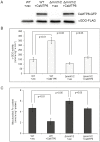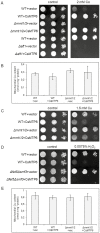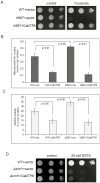Metal tolerance protein MTP6 affects mitochondrial iron and manganese homeostasis in cucumber
- PMID: 30304441
- PMCID: PMC6305187
- DOI: 10.1093/jxb/ery342
Metal tolerance protein MTP6 affects mitochondrial iron and manganese homeostasis in cucumber
Erratum in
-
Corrigendum to: Metal tolerance protein MTP6 affects mitochondrial iron and manganese homeostasis in cucumber.J Exp Bot. 2019 Jan 1;70(1):369. doi: 10.1093/jxb/ery399. J Exp Bot. 2019. PMID: 30481330 Free PMC article. No abstract available.
Retraction in
-
RETRACTION NOTICE.J Exp Bot. 2020 Oct 7;71(19):6187. doi: 10.1093/jxb/erz449. J Exp Bot. 2020. PMID: 31972017 Free PMC article. No abstract available.
Abstract
Members of the cation diffusion facilitator (CDF) family have been identified in all kingdoms of life. They have been divided into three subgroups, namely Zn-CDF, Fe/Zn-CDF, and Mn-CDF, based on their putative specificity to transported metal ions. The plant metal tolerance protein 6 (MTP6) proteins fall into the Fe/Zn-CDF subgroup; however, their function in iron/zinc transport has not yet been confirmed. Here, we characterized the MTP6 protein from cucumber, Cucumis sativus. When expressed in yeast and in protoplasts isolated from Arabidopsis cells, CsMTP6 localized in mitochondria and contributed to the efflux of Fe and Mn from these organelles. Immunolocalization of CsMTP6 in cucumber membranes confirmed this association with mitochondria. Root expression and protein levels of CsMTP6 were significantly up-regulated in conditions of Fe deficiency and excess, but were not affected by Mn availability. These results indicate that MTP6 proteins contribute to the distribution of Fe and Mn between the cytosol and mitochondria of plant cells, and are regulated by Fe to maintain mitochondrial and cytosolic iron homeostasis under varying conditions of Fe availability.
Figures








Similar articles
-
Cucumber metal tolerance protein 7 (CsMTP7) is involved in the accumulation of Fe in mitochondria under Fe excess.Plant J. 2018 Sep;95(6):988-1003. doi: 10.1111/tpj.14006. Epub 2018 Jul 17. Plant J. 2018. Retraction in: Plant J. 2020 Aug;103(3):1256. doi: 10.1111/tpj.14934. PMID: 29932267 Retracted.
-
Cucumber metal transport protein MTP8 confers increased tolerance to manganese when expressed in yeast and Arabidopsis thaliana.J Exp Bot. 2014 Oct;65(18):5367-84. doi: 10.1093/jxb/eru295. Epub 2014 Jul 19. J Exp Bot. 2014. Retraction in: J Exp Bot. 2020 Oct 7;71(19):6187. doi: 10.1093/jxb/erz449. PMID: 25039075 Free PMC article. Retracted.
-
Cucumber metal tolerance protein CsMTP9 is a plasma membrane H⁺-coupled antiporter involved in the Mn²⁺ and Cd²⁺ efflux from root cells.Plant J. 2015 Dec;84(6):1045-58. doi: 10.1111/tpj.13056. Epub 2015 Dec 10. Plant J. 2015. Retraction in: Plant J. 2020 Aug;103(3):1256. doi: 10.1111/tpj.14934. PMID: 26485215 Retracted.
-
Manganese (Mn) and iron (Fe): interdependency of transport and regulation.Neurotox Res. 2010 Aug;18(2):124-31. doi: 10.1007/s12640-009-9130-1. Epub 2009 Nov 18. Neurotox Res. 2010. PMID: 19921534 Free PMC article. Review.
-
Transition metal transporters in plants.J Exp Bot. 2003 Dec;54(393):2601-13. doi: 10.1093/jxb/erg303. Epub 2003 Oct 29. J Exp Bot. 2003. PMID: 14585824 Review.
Cited by
-
The mitochondrial iron exporter genes MMT1 and MMT2 in yeast are transcriptionally regulated by Aft1 and Yap1.J Biol Chem. 2020 Feb 7;295(6):1716-1726. doi: 10.1074/jbc.RA119.011154. Epub 2020 Jan 2. J Biol Chem. 2020. PMID: 31896574 Free PMC article.
-
Genome-Wide Identification of Metal Tolerance Protein Genes in Populus trichocarpa and Their Roles in Response to Various Heavy Metal Stresses.Int J Mol Sci. 2020 Feb 29;21(5):1680. doi: 10.3390/ijms21051680. Int J Mol Sci. 2020. PMID: 32121430 Free PMC article.
-
Mitochondrial Iron Transporters (MIT1 and MIT2) Are Essential for Iron Homeostasis and Embryogenesis in Arabidopsis thaliana.Front Plant Sci. 2019 Nov 25;10:1449. doi: 10.3389/fpls.2019.01449. eCollection 2019. Front Plant Sci. 2019. PMID: 31850005 Free PMC article.
-
Recent Trends in Enhancing the Resistance of Cultivated Plants to Heavy Metal Stress by Transgenesis and Transcriptional Programming.Mol Biotechnol. 2019 Oct;61(10):725-741. doi: 10.1007/s12033-019-00202-5. Mol Biotechnol. 2019. PMID: 31372919 Review.
-
Potato biofortification: an effective way to fight global hidden hunger.Physiol Mol Biol Plants. 2021 Oct;27(10):2297-2313. doi: 10.1007/s12298-021-01081-4. Epub 2021 Oct 7. Physiol Mol Biol Plants. 2021. PMID: 34744367 Free PMC article. Review.
References
-
- Arrivault S, Senger T, Krämer U. 2006. The Arabidopsis metal tolerance protein AtMTP3 maintains metal homeostasis by mediating Zn exclusion from the shoot under Fe deficiency and Zn oversupply. The Plant Journal 46, 861–879. - PubMed
-
- Asada K, Takahashi M, Nagate M. 1974. Assay and inhibitors of spinach superoxide dismutase. Agricultural and Biological Chemistry 38, 471–473.
-
- Bradford MM. 1976. A rapid and sensitive method for the quantitation of microgram quantities of protein utilizing the principle of protein-dye binding. Analytical Biochemistry 72, 248–254. - PubMed
Publication types
MeSH terms
Substances
Associated data
LinkOut - more resources
Full Text Sources
Other Literature Sources
Medical

